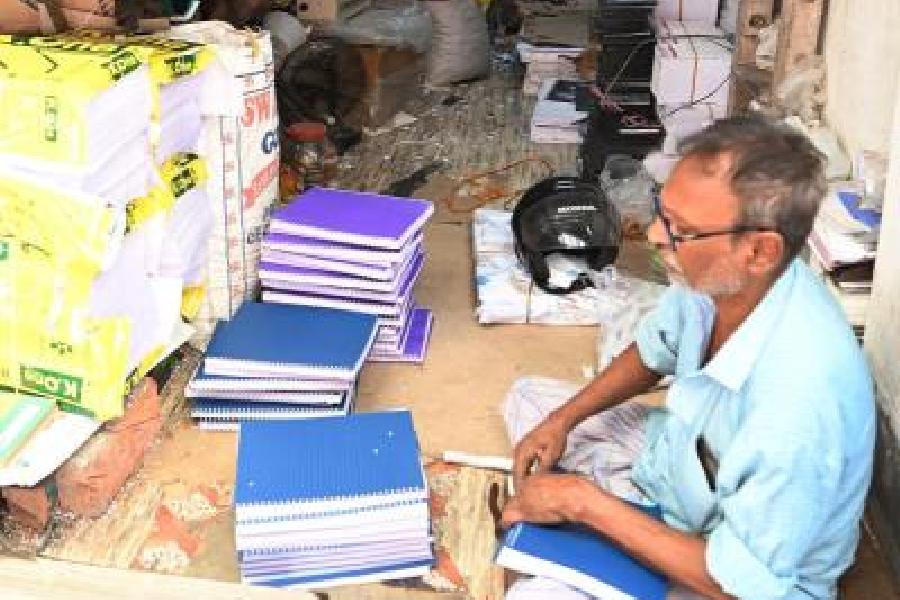Unlettered men but expert in making theses.
A group of students, researchers and teachers on Friday toured a neighbourhood in north-central Calcutta that happens to be the home and workplace of several such experts.
They walked along roads like Budhu Ostagar Lane, Patwar Bagan Lane and Baithakkhana Road near Sealdah and College Street. The area, collectively called Daftaripara, was once home to hundreds of book bindery units, printing presses and other ancillary units. It was a vital cog in Calcutta’s formidable publishing industry.
A few units still remain but in a derelict condition. Digital printing has put many units out of work. Book binding has also become extensively mechanised. Publishers have shifted a majority of their binding work to more advanced units that have the resources to deliver in bulk at short notice.
Many PhD students come to Daftaripara, part of Ward 37 of the Kolkata Municipal Corporation, to get their thesis papers bound. The men who do the work are often unlettered.
The walk was organised by St Paul’s Cathedral Mission College and Know Your Neighbour, a campaign that promotes interactions to strengthen social amity.
They passed by several such units, often dimly lit and derelict, where workers were busy stitching, binding and putting hard covers on books.
“The owners and workers in these units cannot be segregated. They get a paltry amount after 12 hours of labour. But they work together and live like a family,” Sabir Ahamed, convener of the Know Your Neighbour campaign, told the participants.
Daftar itself is a Persian word for office. Para means neighbourhood in Bengali.
“Many words used in these units every day — like aara, astar, takti, tasma — have Arabic and Persian origins. At one point of time, binderies were dominated by Muslim workers from what was then East Bengal. Post-Partition, many Hindus fleeing what was then East Pakistan also arrived in Daftaripara in search of life and livelihood, more so because of its proximity with Sealdah station. But these words have stayed,” he said.
He said this working together of Hindus and Muslims was a prime example of “Yukta Sadhana” that Nobel laureate Amartya Sen often stresses as a way of collaboration that goes beyond mere tolerance and is imperative to resist the present onslaught of religious polarisation.
The walk started from the Victoria Institution (College). Originally named Native Ladies Normal and Adult School, it was founded on February 1, 1871, by Keshub Chandra Sen under the auspices of the Indian Reform Association of which he was the president. Keshub Chandra Sen, a social reformer, was a champion of women’s education.
Originally, the binderies were concentrated in the area now known as Tea Board.
“Binderies have played an important role in Calcutta after the establishment of Fort William College. The binding business was earlier concentrated in Old Chinabazar. It was mainly because of its proximity to new buildings like the high court, the Imperial Secretariat and the General Post Office in the Dalhousie Area in the 1870s. Gradually, land prices in this area shot up, forcing the binderies to move northwards,” said Ahamed.
On Thursday, the Know Your Neighbour campaign organised a seminar at St Paul’s College that had discussions on Daftaripara.
Abhijit Roy, professor of film studies at Jadavpur University, was one of the participants. In 2012-13, he led a research project on Daftaripara for JU’s school of media communication and culture.
“Unlike printing technology, which has gone through stages of major transformation to finally arrive at the digital age, the technology of book binding and the nature of its interface with manual labour have not changed significantly,” says the project report.
“It seems as though practically every phase of the relationship between human and machine can still be witnessed at Daftaripara,” the report says.
“It is a very welcome initiative. Students and young minds are going to explore the neighbourhood. It is a working class neighbourhood with a lot of Muslims. Such efforts ensure that learning is not limited to classrooms,” Roy told Metro.
Ahamed said the current participants will document the interactions and experiences and make them part of a public repository.











